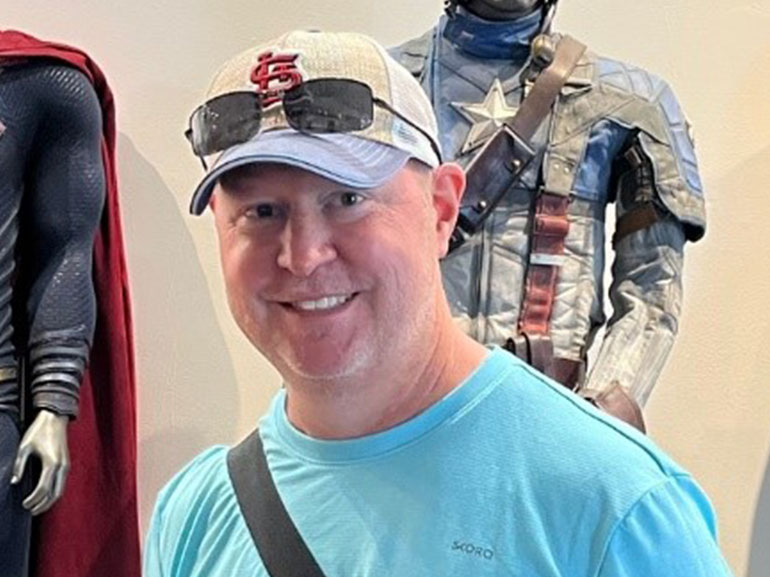Stephen's story

As a clinical liaison at SSM Health Rehabilitation Hospital – Richmond Heights, Steve Allbright spends his days evaluating patients who have been referred to the rehabilitation hospital for admission. He never expected that he would become the patient.
An avid runner, biker and CrossFit athlete, Steve is very active and works to maintain a healthy lifestyle. One Friday, Steve went to the gym and completed an intense workout. While walking to his car, he began to feel dizzy and was having difficulty walking. He went to urgent care, where he underwent a CT scan. When the scan showed nothing of concern, a physician prescribed Steve medication to help with his symptoms. The physician thought that Steve might be developing shingles, a viral infection that causes a painful rash, so they gave him Benadryl via an IV infusion as well as a course of steroids.
Steve felt much better and proceeded to spend the weekend doing his usual activities. The following Monday morning, he went for a walk then jumped on a conference call. After the call ended, Steve’s original symptoms suddenly returned with the addition of blurred vision. He recalls feeling like the room was spinning and being off balance. Steve knew something was very wrong and was rushed to the closest emergency room.
An MRI showed that Steve had suffered a stroke caused by a vertebral artery dissection, which is when a tear occurs in one or more tissue layers that make up the vertebral artery. When blood is trapped between the layers of the artery, a clot can form which disrupts blood flow and can lead to the swelling of the artery. Steve was immediately started on IV blood thinners and spent the next three days in the ICU. He also developed persistent hiccups, which can occur in stroke patients who have suffered a disruption to their brain’s breathing center.
Once stabilized, Steve’s doctors suggested inpatient rehabilitation as the next step in his recovery. Unaware that Steve worked at SSM Health Rehabilitation Hospital – Richmond Heights, physicians suggested he be transferred to a competing rehab facility. Steve quickly requested a referral to his hospital, as he knew he would be in excellent hands with the physicians and therapists who had helped so many patients before him.
Exactly one week after he first began experiencing symptoms, Steve arrived at SSM Rehabilitation Hospital – his home away from home. Steve’s physician-led care team noted he was continuing to have trouble with his vision, including double vision. He was also struggling with balance and involuntarily kept leaning to his left side. Additionally, Steve was continuing to experience dizziness that was worse with movement.
In physical therapy, Steve’s balance was the biggest barrier to overcome. Therapists worked on how to safely move from sitting to standing with a walker. They also practiced balance and stabilization by having Steve spend time on his hands and knees as well as in a kneeling position, which then involved standing up with the external support of a mat or chair. Steve’s therapists also utilized the LiteGait, a bodyweight supported harness that provided him a safe environment while addressing his balance deficits. Additionally, Steve used ankle weights to improve awareness and positioning of his left leg during sessions.
Meanwhile, occupational therapists worked on improving Steve’s vision and proprioception, which is the sense that lets us perceive the location, movement, and action of parts of the body. Steve also met with a neuro-optometrist who recommended a prism lens to correct the double vision. A prism added to eyeglasses bends light before it travels through the eye, thus redirecting light to the right place on the retina in each eye. The brain then fuses the two images together to produce one, clear picture. The use of prism glasses significantly helped Steve with his balance while walking and performing other activities.
Steve’s therapy team also guided him in using a Brock String, a common vision therapy tool that consists of 10-15 feet of white flexible cord or string with colored wooden beads that can be moved to various positions along the length of the string. The Brock String offers instant feedback to the participant if their eyes are working together to focus on an object at various distances. Steve found this helped improve his double vision helped to refocus his eyes. He also used the Bioness Integrated Therapy System (BITS) device, which has an interactive touch screen to improve hand-eye coordination, reaction time, depth perception and working memory for patients with a variety of neurological conditions.
Eleven days after he arrived at SSM Health Rehabilitation Hospital, Steve had made great improvements in his balance and vision. He plans to continue his recovery at the SSM Health Day Institute, a specialized outpatient rehabilitation program.
Steve reflected on his experience, sharing: “It is a humbling experience when you are independent all your life and then suddenly have to rely on others for things you take for granted every day. But rehabilitation reinforces that you can do it and regain your independence.”